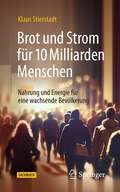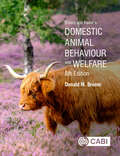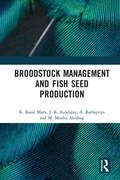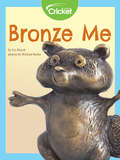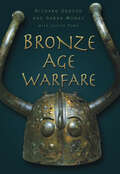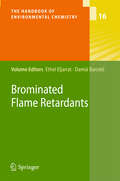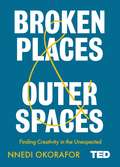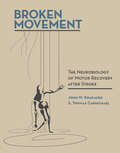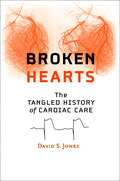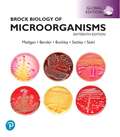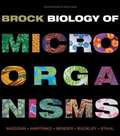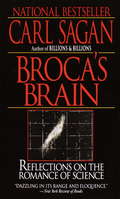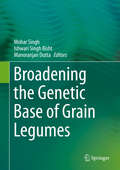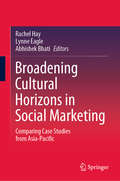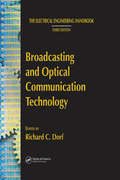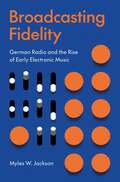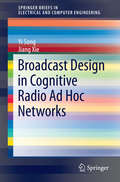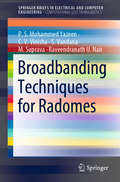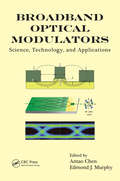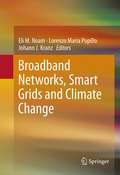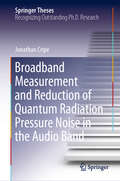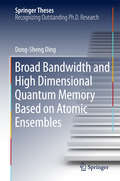- Table View
- List View
Brot und Strom für 10 Milliarden Menschen: Nahrung und Energie für eine wachsende Bevölkerung
by Klaus StierstadtWie lange liefert die Sonne genug Energie für unsere wachsende Bevölkerung?Reichen unsere Dächer aus, um ausreichend Solarstrom zu erzeugen?Stellen Pflanzen und Algen genug Nahrung und Sauerstoff für alle Lebewesen bereit?Millionen Menschen hungern. Strom ist für Milliarden Menschen ein Traum oder zumindest ein Luxusgut. Diese Buch diskutiert mit Hilfe verständlich dargestellter Physik wie weit es zu wenig Ressourcen gibt und wie weit es schlicht eine Problem der Verteilung ist.Das Buch ist gleichermaßen geeignet für Interessierte wie für Personen mit physikalischer Ausbildung. Zahlreiche Vergleiche und Erklärungen zeichnen ein anschauliches Bild, welches durch zahlreiche Abschätzungen und physikalische Details ergänzt wird.
Broom and Fraser's Domestic Animal Behaviour and Welfare
by Donald BroomCompletely updated and revised, and synthesizing the recent explosion in animal welfare literature, the sixth edition of this best-selling textbook continues to provide a thorough overview of behaviour and welfare of companion and farm animals, including fish. The introductory section has been completely revised, with all following chapters updated, redesigned and improved to reflect our changing understanding. This edition includes: - New and revised chapters on climate change and sustainability, ethics, and philosophy to ensure that the book provides the latest information in a changing world; - New information on human interactions with other animal species, big data, modern technologies, brain function, emotions and behaviour; - Solutions and advice for common abnormal behaviours. Written by a world-leading expert and key opinion leader in animal behaviour and welfare, this text provides a highly accessible guide to the subject. It is an essential foundation for any veterinary, animal science, animal behaviour or welfare-focused undergraduate or graduate course.
Broodstock Management and Fish Seed Production
by K. Karal Marx J. K. Sundaray A. Rathipriya M. Muthu AbishagThe book entitled “Broodstock Management and Fish Seed Production” provides information relating to commercially cultivable fresh water fishes, broodstock management, fish seed production technology, fish seed quality management including induced breeding with neat illustration. Increasing the aquaculture production can be achieved through the supply of quality fish seed. This book will be immensely helpful to farmers, hatchery managers, entrepreneurs and fisheries graduates pursuing research in the area of freshwater broodstock management and sustainable development of freshwater aquaculture in the country. Note: T& F does not sell or distribute the Hardback in India, Pakistan, Nepal, Bhutan, Bangladesh and Sri Lanka.
Bronze Me
by Liz HuyckHave you ever wondered how bronze statues are made? Bronze is a type of metal, which can be made into different forms when heated at high temperatures. Bronze can be poured into a mold to create a statue. It takes years to master the art of making bronze statues; it includes a five-step process. Learn more about making bronze statues!
Bronze Age Warfare
by Richard Osgood Sarah MonksThe Bronze Age, so named because of the technological advances in metalworking and countless innovations in the manufacture and design of tools and weapons, is among the most fascinating periods in human history. Archaeology has taught us much about the way of life, habits and homes of Bronze Age people, but as yet little has been written about warfare. What was Bronze Age warfare like? How did people fight and against whom? What weapons were used? Did they fortify their settlements, and, if so, were these intended as defensive or offensive structures? in response to these and many other questions, Bronze Age Warfare offers and intriguing insight into warfare and society, life and death in Europe 4000 years ago. It describes the surviving evidence of conflict - fortifications, weapons and body protection, burials, human remains and pictorial evidence - and seeks to understand the role played by aggression in the prehistoric world.
Brominated Flame Retardants (The Handbook of Environmental Chemistry #16)
by Damià Barceló Ethel EljarratBrominated flame retardants are one of the last classes of halogenated compounds that are still being produced worldwide and used in large quantities in many applications. They are used in plastics, textiles, electronic circuitry, and other materials to prevent fires. This volume covers the state-of-the-art of the analysis, fate and behaviour of brominated flame retardants. Experts in the field provide an overview of the compounds' physico-chemical properties and uses, their occurrence in the environment and biota, advanced chemical analytical methods, degradation studies, toxicological effects and human exposure. This book is a valuable and comprehensive source of information for environmental scientists interested in brominated flame retardant issues, and for authorities and producers.
Broken Places & Outer Spaces: Finding Creativity In The Unexpected (Ted 2 Ser.)
by Nnedi OkoraforNnedi Okorafor was never supposed to be paralyzed. A college track star and budding entomologist, Nnedi’s lifelong battle with scoliosis was just a bump in her plan - something a simple surgery would easily correct. But when Nnedi wakes from the surgery to find she can’t move her legs, her entire sense of who she is begins to waver. Confined to a hospital bed for months, unusual things begin to happen. Psychedelic bugs crawl her hospital walls; strange dreams visit her nightly. She begins to feel as if she’s turning into a cyborg. Unsure if she’ll ever walk again, Nnedi begins to put these experiences into writing, conjuring up strange, fantastical stories. What Nnedi discovers during her confinement would prove to be the key to her life as a successful science fiction writer: In science fiction, when something breaks, something greater often emerges from the cracks. While she may be bedridden, instead of stopping her journey Nnedi’s paralysis opens up new windows in her mind, kindles her creativity and ultimately leads her to become more alive than she ever could have imagined. Nnedi takes the reader on a journey from her hospital bed deep into her memories, from her painful first experiences with racism as a child in Chicago to her powerful visits to her parents’ hometown in Nigeria, where she got her first inkling that science fiction has roots beyond the West. This was not the Africa that Nnedi knew from Western literature - an Africa that she always read was a place left behind. The role of technology in Nigeria opened her eyes to future-looking Africa: cable TV and cell phones in the village, 419 scammers occupying the cybercafés, the small generator connected to her cousin’s desktop computer, everyone quickly adapting to portable tech devices due to unreliable power sources. Nnedi could see that Africa was far from broken, as she’d been taught, and her experience there planted the early seeds of sci-fi - a genre that speculates about technologies, societies, and social issues - from an entirely new lens. In Broken Places & Outer Spaces, Nnedi uses her own experience as a jumping off point to follow the phenomenon of creativity born from hardship. From Frida Kahlo to Mary Shelly, she examines great artists and writers who have pushed through their limitations, using hardship to fuel their work. Through these compelling stories and her own, Nnedi reveals a universal truth: What we perceive as limitations have the potential to become our greatest strengths - far greater than when we were unbroken.
Broken Movement: The Neurobiology of Motor Recovery after Stroke (The\mit Press Ser.)
by S. Thomas Carmichael John W. KrakauerAn account of the neurobiology of motor recovery in the arm and hand after stroke by two experts in the field.Stroke is a leading cause of disability in adults and recovery is often difficult, with existing rehabilitation therapies largely ineffective. In Broken Movement, John Krakauer and S. Thomas Carmichael, both experts in the field, provide an account of the neurobiology of motor recovery in the arm and hand after stroke. They cover topics that range from behavior to physiology to cellular and molecular biology. Broken Movement is the only accessible single-volume work that covers motor control and motor learning as they apply to stroke recovery and combines them with motor cortical physiology and molecular biology. The authors cast a critical eye at current frameworks and practices, offer new recommendations for promoting recovery, and propose new research directions for the study of brain repair.Krakauer and Carmichael discuss such subjects as the behavioral phenotype of hand and arm paresis in human and non-human primates; the physiology and anatomy of the motor system after stroke; mechanisms of spontaneous recovery; the time course of early recovery; the challenges of chronic stroke; and pharmacological and stem cell therapies. They argue for a new approach in which patients are subjected to higher doses and intensities of rehabilitation in a more dynamic and enriching environment early after stroke. Finally they review the potential of four areas to improve motor recovery: video gaming and virtual reality, invasive brain stimulation, re-opening the sensitive period after stroke, and the application of precision medicine.
Broken Hearts: The Tangled History of Cardiac Care
by David S. JonesA history illustrating the complexity of medical decision making and risk.Still the leading cause of death worldwide, heart disease challenges researchers, clinicians, and patients alike. Each day, thousands of patients and their doctors make decisions about coronary angioplasty and bypass surgery. In Broken Hearts David S. Jones sheds light on the nature and quality of those decisions. He describes the debates over what causes heart attacks and the efforts to understand such unforeseen complications of cardiac surgery as depression, mental fog, and stroke.Why do doctors and patients overestimate the effectiveness and underestimate the dangers of medical interventions, especially when doing so may lead to the overuse of medical therapies? To answer this question, Jones explores the history of cardiology and cardiac surgery in the United States and probes the ambiguities and inconsistencies in medical decision making. Based on extensive reviews of medical literature and archives, this historical perspective on medical decision making and risk highlights personal, professional, and community outcomes.
Broken Arrow Boy
by Adam MooreWinner of the Gold Award in the 1990 Written and Illustrated By... Contest. At nine years of age, Adam Moore wrote and illustrated BROKEN ARROW BOY, and his book was chosen as a Gold Award Winner in THE 1989 NATIONAL WRITTEN & ILLUSTRATED BY... AWARDS CONTEST FOR STUDENTS. Adam lives in Broken Arrow, Oklahoma, with his parents, Rebecca and Paul, and his two brothers, Ryan, age 13, and Tyler, age 8. When Adam was eight years old, he fell and ran an arrow into his head. The accident led him into a world of hospitals, operations, and physical therapy. These experiences inspired him to create his book which tells of his remarkable recovery. At Indian Springs Elementary School, Adam is a straight "A" fifth-grade student. He has been enrolled in the school's Kaleidoscope gifted program since first grade. At school Adam is an active member of the Computer Club, serves as a Safety Patrol Officer, and has also been a Student Council Representative. He had the honor of having his work selected for publication in his school district's Young Authors' Student Anthology (a short story in 1988-89; and a poem and drawing in 1989-90). In February of 1990, he also had the pleasure of completing Cub Scouts when he attained the Arrow of Light rank. him sur Adam is also an avid collector of stamps, coins and baseball cards. In his spare time, he swims, rides his bicycle, and plays Nintendo and pinball. Adam's weird humor. It was this same wonderful humor that helped him survive and struggled to recuperate from his accident.
Brock Biology of Microorganisms, Global Edition
by Michael Madigan Jennifer Aiyer Daniel Buckley W. Sattley David StahlAuthoritative. Accurate. Accessible. Brock Biology of Microorganisms sets the standard for accuracy, impeccable scholarship, a visually stunning art program, and the use of cutting-edge research to illustrate basic concepts. The text guides students through the six major themes of microbiology ― Evolution, CellStructure and Function, Metabolic Pathways, Information Flow and Genetics,Microbial Systems, and the Impact of Microorganisms ― as outlined by theAmerican Society for Microbiology Conference on Undergraduate Education(ASMCUE). This robust and modern approach takes students through the genomics revolution and “omics” maze that has transformed microbiology and shares powerful tools that microbiologists use to probe deeper and further into the microbial world than ever before. The 16th Edition expands the extraordinary art program to ensure students experience microbiology as a visual science while providing an overview of the microbial world with basic principles that students all need to master. Each chapter’s theme focuses on a recent discovery that connects students with the most current science and engages them with exciting, real-world topics.
Brock Biology of Microorganisms, Fourteenth Edition
by Michael T. Madigan John M. Martinko Kelly S. Bender Daniel H. Buckley David A. StahlThe Fourteenth Edition seamlessly integrates the most current science, paying particular attention to molecular biology and how the genomic revolution has changed and is changing the field. This edition offers a streamlined, modern organization with a consistent level of detail and updated, visually compelling art program.
Broca's Brain: Reflections on the Romance of Science
by Carl SaganCarl Sagan, writer and scientist, returns from the frontier to tell us about how the world works. In his delightfully down-to-earth style, he explores and explains a mind-boggling future of intelligent robots, extraterrestrial life and its consquences, and other provocative, fascinating quandries of the future that we want to see today.From the Paperback edition.
Broadening the Genetic Base of Grain Legumes
by Mohar Singh Ishwari Singh Bisht Manoranjan DuttaGrain legumes play significant and diverse role in the farming systems and provide nutrition security to the largely vegetarian and relatively poorer people around the world. These are ideal crops for achieving three simultaneous developmental goals viz. reducing poverty, improving human health and nutrition and enhancing ecosystem resilience. Globally, grain legumes are the second most important crop group next only to cereals but a large proportion of area of it is under rainfed-low input systems as compared to cereals contributing to lower yields. The other important factor responsible for reduced yield in grain legumes is the narrow genetic base of the present day pulse varieties. In order to break the yield barriers of these cultivars, new sources of genes/ alleles need to be identified and suitably incorporated into the adapted background. The information on various aspects of grain legume improvement although has been considerable in the recent past, these information are highly scattered and not available at one place. The present book consists of comprehensive and latest crop-wise information on important grain legumes of the world including their distribution, gene pool, systematics, status of genetic and genomic resources, production constraints, traits of importance, crop improvement methodologies - both conventional as well as contemporary and future strategies to be adopted for comprehensive grain legume improvement in various agro-ecological target areas of the globe. The chapters have been contributed by eminent crop experts from across the world engaged in research in their respective crops for the past several years thus providing a rare insight into the crop specific constraints and prospects drawing from their rich overall experience. The book therefore will be a useful source of information to the grain legume researchers, students, policy planners and developmental experts alike.
Broadening Cultural Horizons in Social Marketing: Comparing Case Studies from Asia-Pacific
by Lynne Eagle Rachel Hay Abhishek BhatiThis book presents a series of empirically based case studies conducted by social change scholars from Asia-Pacific, showcasing the latest social marketing approaches geared at improving societal well-being in the region. Cutting across cultural perspectives, the contents gather ideas on social marketing campaigns and strategies from around the region and use these case studies as a platform to address concomitant challenges in employing marketing tools to positively change social behaviour. The selection of case studies covers and compares aspects of public health and well-being, and public environmental consciousness in terms of driving attitudes towards implementing improved sustainability in developing and developed countries. Drawing on related policies and legislation, and examining social behaviour at the individual, community, and organisational levels, the authors propose innovative new methods in social marketing and social change research. The book is of interest to researchers and practitioners in social marketing, business ethics, behavioural science, public health, and development studies.
Broadcasting and Optical Communication Technology (The Electrical Engineering Handbook)
by Richard C. DorfIn two editions spanning more than a decade, The Electrical Engineering Handbook stands as the definitive reference to the multidisciplinary field of electrical engineering. Our knowledge continues to grow, and so does the Handbook. For the third edition, it has been expanded into a set of six books carefully focused on a specialized area or field of study. Broadcasting and Optical Communication Technology represents a concise yet definitive collection of key concepts, models, and equations in the fields of broadcasting and optical communication, thoughtfully gathered for convenient access.Addressing the challenges involved in modern communications networks, Broadcasting and Optical Communication Technology explores communications, information theory, and devices, covering all the basic information needed for a thorough understanding of these areas. It also examines the emerging areas of adaptive estimation and optical communication, including lightwave technology, long-distance fiber optic communications, and photonic networks. Articles include defining terms, references, and sources of further information.Encompassing the work of the world's foremost experts in their respective specialties, Broadcasting and Optical Communication Technology presents the latest developments, the broadest scope of coverage, and new material on mobile communications. It offers fast, convenient access to specialists in need of detailed reference on the job.
Broadcasting Fidelity: German Radio and the Rise of Early Electronic Music
by Myles W. JacksonA landmark history of early radio in Germany and the quest for broadcast fidelityWhen we turn on a radio or stream a playlist, we can usually recognize the instrument we hear, whether it&’s a cello, a guitar, or an operatic voice. Such fidelity was not always true of radio. Broadcasting Fidelity shows how the problem of broadcast fidelity pushed German scientists beyond the traditional bounds of their disciplines and led to the creation of one of the most important electronic instruments of the twentieth century.In the early days of radio, acoustical distortions made it hard for even the most discerning musical ears to differentiate instruments and voices. The physicists and engineers of interwar Germany, with the assistance of leading composers and musicians, tackled this daunting technical challenge. Research led to the invention in 1930 of the trautonium, an early electronic instrument capable of imitating the timbres of numerous acoustical instruments and generating novel sounds for many musical genres. Myles Jackson charts the broader political and artistic trajectories of this instrument, tracing how it was embraced by the Nazis and subsequently used to subvert Nazi aesthetics after the war and describing how Alfred Hitchcock commissioned a later version of the trautonium to provide the sounds of birds squawking and flapping their wings in his 1963 thriller The Birds.A splendid work of scholarship by an acclaimed historian of science, Broadcasting Fidelity reveals how the interplay of science, technology, politics, and culture gave rise to new aesthetic concepts, innovative musical genres, and the modern discipline of electroacoustics.
Broadcast Design in Cognitive Radio Ad Hoc Networks (SpringerBriefs in Electrical and Computer Engineering)
by Yi Song Jiang XieThis SpringerBrief investigates the special challenges of broadcast design in cognitive radio (CR) ad hoc networks. It introduces two broadcast protocols in CR ad hoc networks: a quality-of-service based broadcast protocol under blind information and a fully-distributed broadcast protocol with collision avoidance. A novel unified analytical model is also presented to analyze the performance of the broadcast protocols. This is the first book dedicated to the unique broadcast design challenges in CR ad hoc networks. The authors also discuss the recent research on the performance analysis of broadcast protocols. Broadcast Design In Cognitive Radio Ad Hoc Networks is designed for professionals and researchers working in the wireless networks industry. Advanced-level students in electrical engineering and computer science, especially those focused on wireless networks will find this information very valuable.
Broadbanding Techniques for Radomes (SpringerBriefs in Electrical and Computer Engineering)
by Raveendranath U. Nair M. Suprava S. Vandana P. S. Mohammed Yazeen C. V. VinishaThis SpringerBrief details various techniques employed for enhancing the transmission efficiency of radomes by modifying the radome wall configurations. These broadbanding techniques are based on inclusion of metallic wire-grids/meshes in the radomewalls, inclusion of metallic strip-gratings in the radome layers, inclusion of FSS based structures in between the radome layers and the use of inhomogeneous dielectric structures as radome wall. The volume provides detailed chapter-wise explanation of the design aspects and discusses the performance analysis of the modified radome wall configurations. It will be of interest to researchers, academicians and students working in the field of radomes.
Broadband Terahertz Communication Technologies
by Jianjun YuThis book highlights the comprehensive knowledge and latest progress in broadband terahertz (THz) technology. THz communication technology is believed to be one of the major choices that succeed the fifth-generation (5G) communication technology. With years of efforts, the author’s team has created a number of world records in the generation, transmission, and reception of ultra wideband THz signal, realizing the MIMO transmission and reception of THz communication, the THz signal transmission with communication capacity of 1 Tbit / s, and the optical fiber and THz integrated transmission. A variety of linear and nonlinear algorithms for multi-carrier and single-carrier THz communication systems are developed, which greatly improves the transmission performance of broadband systems. The book covers in details the broadband THz signal generation, long-distance transmission, and high sensitivity detection. It is of great reference value for researchers, engineers, and graduate students in optical and wireless communications.
Broadband Optical Modulators: Science, Technology, and Applications
by Edmond J. Murphy Antao Chen"�provides the full, exciting story of optical modulators. � a comprehensive review, from the fundamental science to the material and processing technology to the optimized device design to the multitude of applications for which broadband optical modulators bring great value. � Especially valuable in my view is that the authors are internationally
Broadband Networks, Smart Grids and Climate Change
by Eli M. Noam Lorenzo Maria Pupillo Johann J. KranzIn smart grids the formerly separated worlds of energy and telecommunication converge to an interactive and automated energy supply system. Driven by social, legal, and economic pressures, energy systems around the globe are updated with information and communication technology. These investments aim at enhancing energy efficiency, securing affordable energy supply, and mitigate climate change. In Broadband Networks, Smart Grids and Climate Change, renowned scholars and managers from the fields of energy and telecommunication address key questions related to technological, strategic, and regulatory issues revealing consequences and opportunities for businesses evolving with smart grids. In particular, this book analyzes: (1) the effects on climate change protection (2) national energy and broadband politics (3) regulatory approaches and requirements (4) emerging business models
Broadband Measurement and Reduction of Quantum Radiation Pressure Noise in the Audio Band (Springer Theses)
by Jonathan CripeThis book presents a direct measurement of quantum back action, or radiation pressure noise, on a macroscopic object at room temperature across a broad bandwidth in the audio range. This noise source was predicted to be a limitation for gravitational wave interferometers in the 1980s, but it has evaded direct characterization in the gravitational wave community due to the inherent difficult of reducing thermal fluctuations below the quantum back action level. This back action noise is a potential limitation in Advanced LIGO and Advanced Virgo, and Cripe’s experiment has provided a platform for the demonstration of quantum measurement techniques that will allow quantum radiation pressure noise to be reduced in these detectors. The experimental techniques Cripe developed for this purpose are also applicable to any continuous measurement operating near the quantum limit, and could lead to the possibility of observing non-classical behavior of macroscopic objects.
Broad Bandwidth and High Dimensional Quantum Memory Based on Atomic Ensembles (Springer Theses)
by Dong-Sheng DingThis thesis presents an experimental study of quantum memory based on cold atomic ensembles and discusses photonic entanglement. It mainly focuses on experimental research on storing orbital angular momentum, and introduces readers to methods for storing a single photon carried by an image or an entanglement of spatial modes. The thesis also discusses the storage of photonic entanglement using the Raman scheme as a step toward implementing high-bandwidth quantum memory. The storage of photonic entanglement is central to achieving long-distance quantum communication based on quantum repeaters and scalable linear optical quantum computation. Addressing this key issue, the findings presented in the thesis are very promising with regard to future high-speed and high-capacity quantum communications.
British and Irish Butterflies: An Island Perspective
by Roger L Dennis Peter B HardyIslands are special places; they can be havens for unique plants and animals and refuges for wildlife. This book investigates the biogeography of butterfly species over the British islands, particularly the factors that influence their presence on the islands and that have made each island's butterfly fauna distinctive. The book contains a full log of records of species on the islands and much supporting information. The first three chapters set the scene, illustrating the basics of island biogeography theory, their changing circumstances during the current Holocene interglacial, and studies of natural history of British butterflies that mark the islands as the most intensively studied region for wildlife in the world. The book advances by increasing resolution downscale from a European continental perspective, through patterns and changes on the British mainland, a comparison of the two dominant islands of Britain and Ireland, to a close inspection of the dynamics of species on the multitude of offshore islands. Detailed investigations include contrasts in species' richness on the islands and then of the incidences of each species. Case studies highlight the continual turnover of species on islands. Attention is then given to evolutionary changes since the time that glaciers enveloped Europe. A powerful message is conveyed for the maintenance of butterfly species on the smaller British islands now experiencing population losses at a rate unprecedented since the spread of the last ice sheets: the incontrovertible importance of maintaining populations of species on nearby mainland sources for islands as pools for future migrants. This book is enhanced with supporting material. To access the Online Supplementary Appendices below, please visit: http://www.cabi.org/openresources/95061. Supplementary Appendices Chapter 3 3.1a A copy of Dennis and Shreeve (1996) Butterflies on British and Irish Offshore Islands: Ecology and Biogeography. Gem Publishing Company, Wallingford, Oxon 3.1b The main data file for British and Irish offshore islands 3.2 Basic ecological and life history data used to build the indices for migration capacity and colonization ability Supplementary Appendices Chapter 4 4.1 Contemporary Geography Study of British Butterflies: Data 4.2 Contemporary Geography Study of British Butterflies: Analyses Supplementary Appendices Chapter 5 5.1a The European Islands Data File: Recent Sources 5.1b The European Islands Data File: Butterfly Records 5.1c The European Islands Data File: Geographical Data 5.2 Comparison of British and Irish Species Distributions Supplementary Appendices Chapter 6 6.1a Species Incidences on Offshore Islands: Logit Regression Analyses 6.1b Species Incidences on Offshore Islands: Discriminant Function Analyses 6.2 Species Richness and Incidences on Offshore Islands: Predictions Supplementary Appendix Chapter 7 7.1 Records and Data for the Isle of Man
